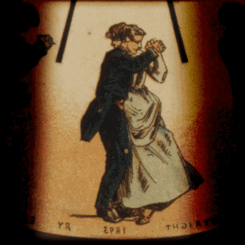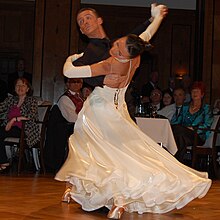Standard dances
Standard dances were originally called all ballroom dances. It is now a collective term for the slow waltz , tango , Viennese waltz , foxtrot , slowfox and quickstep . Together with the Latin American dances , the standard dances form a large part of the dances in the world dance program .
Characteristics and technology
Standard dances are movement dances in which the dancers move expansively - depending on the dance, more or less quickly. The tango is a step dance, the other dances are called swing dances . Another characteristic of the standard dances is the physical contact , through which the dance partners remain connected without interruption.
The Latin American dances, on the other hand, the second group of tournament dances, which also consists of five dances, are danced more stationary and largely without physical contact.
The body contact in the standard dances requires a high degree of balance, posture and mutual guidance. Movement, balance and posture then ensure a harmonious flow of movement for the couples. The Lord leads: He dances forward more often and overlooks the dance floor and thus the sequence of figures. Leading means using the body with its stable contact surfaces by shifting the body's center of gravity in the forward movement. The action of the gentleman is immediately followed by the reaction of the lady and, overall, a harmonious, coordinated action by the couple. When the lady is in the forward action, she has an overview of the area and only gives clues about the free space in front of her; however, the Lord continues to lead.
Attitude and leadership
Standard dances are danced in a closed dance posture. In the four swing dances (slow waltz, Viennese waltz, quickstep and slowfox) the gentleman places his right hand with closed fingers on the lower part of the lady's left shoulder blade. The lady's left hand is placed on the gentleman's right upper arm. The lady grips with her thumb and middle finger (sometimes also with an index finger) between the deltoid and triceps . The lady's right hand rests in the gentleman's left hand between the thumb and forefinger and is held in the gentleman's fingers. Ideally, it is held at eye level with the lady (or the smaller dance partner) and should not exceed the lady's crown, even if there are significant differences in size. The lady holds her arms herself.
Since the tango is a walk and not a swing dance, the posture differs from the other standard dances. The gentleman leads the lady primarily with his body, i. H. with the right part of the chest and the pelvis (in tango usually down to the knee). The two arms serve to give the lady a frame in which she can move. The right hand of the gentleman lies a little lower in the tango than in the swing dances and the fingertips reach up to the spine of the lady. The lady's left hand also grips around the gentleman and lies horizontally with stretched fingers on the back of the gentleman's right arm.
It is also characteristic of some standard dances that the dancers never turn around their own, but always around a common axis.
The leadership of the dance partner is based on the knowledge of which step sequences are possible and at which points the dance partner can easily be moved in a new direction by an impulse . Both dance partners must therefore know the sequence of steps and the sequence of equilibrium positions (stable, unstable) of the dances.
American smooth
International Style describes the type of standard dances as they are danced in Europe, starting from Great Britain . In contrast, the American style is the style of dancing that is cultivated in the United States . There is a noticeable difference. B. in the fact that in American style in the "standard dances" (called American Smooth ) the lady is led in solo turns and so the closed posture is dissolved. Only the following four dances are danced: slow waltz , tango , foxtrot and Viennese waltz .
Tournament dance
In the tournament dance, which is divided into different age groups and performance classes, the five dances are always danced in the above order. Every couple starts in the D-class, in which only slow waltzes, tango and quickstep are danced. According to a fixed key, the couple acquire promotion points and placements and thus advance in their age group via the C, B and A class to the special class (S class), the highest amateur dance class. There are the following age groups: children I and II, juniors I and II, youth (under 19 years), main group (from 19 years) and main group II (28 to 35 years), seniors I (one partner at least 35 years old, the other partner at least 30 years), Seniors II (from 45 years), Seniors III (from 55 years) and Seniors IV (from 65 years).
The sporting organization is subject to the German Dance Sports Association and in Austria the Austrian Dance Sports Association (ÖTSV)
Tournaments
Standard world championships are held regularly . One of the world's largest tournaments for amateurs and professionals in Germany are the German Open Championships in Stuttgart, major amateur tournaments are " Hessen tanzt " in Frankfurt and the " Blue Ribbon " in Berlin.
Well-known standard dancers
- Sascha and Natascha Karabey
- Simone Segatori and Annette Sudol
- Benedetto Ferruggia and Claudia Köhler
- Oliver and Martina Wessel-Therhorn
- Isabel Edvardsson and Marcus Weiß
- Heiko Kleibrink and Giselle Keppel
- William Pino and Alessandra Bucciarelli
- Dmitry Zharkov and Olga Kulikova
- Domenico Soale and Gioia Cerasoli
- Michael Hull
- Mirko Gozzoli
- Alessia Betti
- Edita Daniute
See also

literature
- Irene Heise : Tournament dance standard as a harmonious combination of sport, aesthetics and spirituality. A photo-assisted viewing with 50 exposures. Vienna 2011, ISBN 978-3-9500649-8-8
- Alex Moore : The Ballroom Technique , 1936. This original work has been reprinted numerous times since 1948 by the Imperial Society of Teachers of Dancing (ISTD).
- Alex Moore: Ballroom Dancing ; 9th edition 1986, ISBN 0-7136-2794-8 . This is a detailed elaboration of the earlier work The Ballroom Technique .
- Alex Moore: Ballroom Dancing ; 10th edition 2002, ISBN 0-87830-153-4 .



